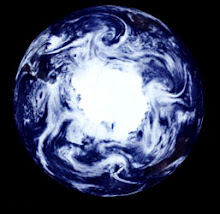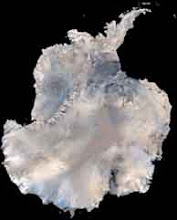 But, no, sadly everything will NOT
But, no, sadly everything will NOT be upside down south of the equator.
Gravity will prevail--even in the south...
Furthermore, strictly speaking Antarctica has not always housed the South Pole. No, just like all continents Antarctica has drifted throughout history, so much so that at one point (500 million years ago) it was near the equator and dinosaurs inhabited the land that is now present day Antarctica.
 SIZE: Antarctica is the fifth biggest continent on Earth and it is roughly 1.5 times the size of the US.
SIZE: Antarctica is the fifth biggest continent on Earth and it is roughly 1.5 times the size of the US. GEOGRAPHY: 98% of Antarctica is covered by a sheet of ice that averages 1 mile in thickness. The majority of the central part of the continent lacks ice completely and constitutes the biggest desert in the world. The ice sheet contains 87% of the world's ice. A general increase in technology has allowed scientists and geologists to generate a picture of the land mass as it would look without the surrounding ice. (Keep in mind that if the ice was really removed the oceans would rise by hundreds of meters and the land mass itself would rise due to the removal of the depressing weight of the ice.) view image
CLIMATE: "On average, Antarctica is the coldest, driest and windiest continent, and has the highest average elevation of all the continents" (Wikipedia) Average temperatures are the coldest on Earth. On average only 6 days a year are above freezing.
Winter* temperatures range from -112 to -130 degrees F.
(*winter in Antarctica is the summer in the US)
Summer temperatures range from 0 to -40 degrees F. (these
are the temperatures that I will be faced with in February)

POPULATION: Antarctica has no permanent residents (aside from penguins), although 1,000 people in winter and roughly 4,000 people during the summer are present.

POPULATION: Antarctica has no permanent residents (aside from penguins), although 1,000 people in winter and roughly 4,000 people during the summer are present.
Antarctic Krill: Small crustaceans that are eaten by many animals, including baleen whales. (photo right)
Arctic Tern: A small bird that flies from the Arctic to the Antarctic and back again each year. (photo above left)
Blue Whale: A baleen whale that is the largest animal that ever lived on Earth.
Earth.
Emperor Penguin: The largest penguin; it lives on
Arctic Tern: A small bird that flies from the Arctic to the Antarctic and back again each year. (photo above left)
Blue Whale: A baleen whale that is the largest animal that ever lived on
 Earth.
Earth.Emperor Penguin: The largest penguin; it lives on
ice packs in Antarctica. (photo left) 
Humpback Whale: A long-flippered baleen whale that sings and frolics in the water. (photo right)
Minke Whale: The smallest baleen whale. It sings and has a white band on each flipper.
Octopus: Octopi have eight legs and live on the sea floor.
Orca or Killer Whale: A toothed whale that lives in small pods.
small pods.
Penguin: Penguins are birds that swim very well but cannot fly.

Humpback Whale: A long-flippered baleen whale that sings and frolics in the water. (photo right)
Minke Whale: The smallest baleen whale. It sings and has a white band on each flipper.
Octopus: Octopi have eight legs and live on the sea floor.
Orca or Killer Whale: A toothed whale that lives in
 small pods.
small pods.Penguin: Penguins are birds that swim very well but cannot fly.
Sea Star: Sea stars, another name for starfish, are animals that live on the ocean floor. (photo left) 
Spectacled Porpoise: A porpoise (a small toothed whale) from the Southern Hemisphere.
Sperm Whale: The largest toothed whale, over 50 feet long. It eats giant squid.
Squid: The squid is a fast-swimming invertebrate with ten arms.
Weddell Seal: The Weddell seal is a large, nocturnal pinniped from Antarctica. (photo right)

Spectacled Porpoise: A porpoise (a small toothed whale) from the Southern Hemisphere.
Sperm Whale: The largest toothed whale, over 50 feet long. It eats giant squid.
Squid: The squid is a fast-swimming invertebrate with ten arms.
Weddell Seal: The Weddell seal is a large, nocturnal pinniped from Antarctica. (photo right)
 POLITICS: Antarctica has no government and belongs to no country. In addition, many different countries have signed the Antarctic Treaty System, which states that Antarctica will remain a scientific preserve and has banned all military activity on the continent. To date 46 countries have signed the treaty, this map shows the original claims.
POLITICS: Antarctica has no government and belongs to no country. In addition, many different countries have signed the Antarctic Treaty System, which states that Antarctica will remain a scientific preserve and has banned all military activity on the continent. To date 46 countries have signed the treaty, this map shows the original claims.




